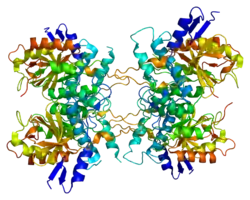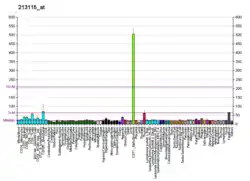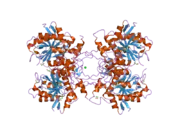ATG4A
Cysteine protease ATG4A is an enzyme that in humans is encoded by the ATG4A gene.[5][6]
| ATG4A | |||||||||||||||||||||||||||||||||||||||||||||||||||
|---|---|---|---|---|---|---|---|---|---|---|---|---|---|---|---|---|---|---|---|---|---|---|---|---|---|---|---|---|---|---|---|---|---|---|---|---|---|---|---|---|---|---|---|---|---|---|---|---|---|---|---|
 | |||||||||||||||||||||||||||||||||||||||||||||||||||
| |||||||||||||||||||||||||||||||||||||||||||||||||||
| Identifiers | |||||||||||||||||||||||||||||||||||||||||||||||||||
| Aliases | ATG4A, APG4A, AUTL2, autophagy related 4A cysteine peptidase, HsAPG4A | ||||||||||||||||||||||||||||||||||||||||||||||||||
| External IDs | OMIM: 300663 MGI: 2147903 HomoloGene: 70873 GeneCards: ATG4A | ||||||||||||||||||||||||||||||||||||||||||||||||||
| |||||||||||||||||||||||||||||||||||||||||||||||||||
| |||||||||||||||||||||||||||||||||||||||||||||||||||
| |||||||||||||||||||||||||||||||||||||||||||||||||||
| |||||||||||||||||||||||||||||||||||||||||||||||||||
| |||||||||||||||||||||||||||||||||||||||||||||||||||
| Wikidata | |||||||||||||||||||||||||||||||||||||||||||||||||||
| |||||||||||||||||||||||||||||||||||||||||||||||||||
Autophagy is the process by which endogenous proteins and damaged organelles are destroyed intracellularly. Autophagy is postulated to be essential for cell homeostasis and cell remodelling during differentiation, metamorphosis, non-apoptotic cell death, and aging. Reduced levels of autophagy have been described in some malignant tumors, and a role for autophagy in controlling the unregulated cell growth linked to cancer has been proposed. This gene encodes a member of the autophagin protein family. The encoded protein is also designated as a member of the C-54 family of cysteine proteases. Transcript variants that encode distinct isoforms have been identified.[6]
References
- GRCh38: Ensembl release 89: ENSG00000101844 - Ensembl, May 2017
- GRCm38: Ensembl release 89: ENSMUSG00000079418 - Ensembl, May 2017
- "Human PubMed Reference:". National Center for Biotechnology Information, U.S. National Library of Medicine.
- "Mouse PubMed Reference:". National Center for Biotechnology Information, U.S. National Library of Medicine.
- Scherz-Shouval R, Sagiv Y, Shorer H, Elazar Z (Apr 2003). "The COOH terminus of GATE-16, an intra-Golgi transport modulator, is cleaved by the human cysteine protease HsApg4A". J Biol Chem. 278 (16): 14053–8. doi:10.1074/jbc.M212108200. PMID 12473658.
- "Entrez Gene: ATG4A ATG4 autophagy related 4 homolog A (S. cerevisiae)".
External links
- Human ATG4A genome location and ATG4A gene details page in the UCSC Genome Browser.
Further reading
- Scherz-Shouval R, Shvets E, Fass E, et al. (2007). "Reactive oxygen species are essential for autophagy and specifically regulate the activity of Atg4". EMBO J. 26 (7): 1749–60. doi:10.1038/sj.emboj.7601623. PMC 1847657. PMID 17347651.
- Ross MT, Grafham DV, Coffey AJ, et al. (2005). "The DNA sequence of the human X chromosome". Nature. 434 (7031): 325–37. Bibcode:2005Natur.434..325R. doi:10.1038/nature03440. PMC 2665286. PMID 15772651.
- Gerhard DS, Wagner L, Feingold EA, et al. (2004). "The status, quality, and expansion of the NIH full-length cDNA project: the Mammalian Gene Collection (MGC)". Genome Res. 14 (10B): 2121–7. doi:10.1101/gr.2596504. PMC 528928. PMID 15489334.
- Kabeya Y, Mizushima N, Yamamoto A, et al. (2005). "LC3, GABARAP and GATE16 localize to autophagosomal membrane depending on form-II formation". J. Cell Sci. 117 (Pt 13): 2805–12. doi:10.1242/jcs.01131. PMID 15169837.
- Ota T, Suzuki Y, Nishikawa T, et al. (2004). "Complete sequencing and characterization of 21,243 full-length human cDNAs". Nat. Genet. 36 (1): 40–5. doi:10.1038/ng1285. PMID 14702039.
- Strausberg RL, Feingold EA, Grouse LH, et al. (2003). "Generation and initial analysis of more than 15,000 full-length human and mouse cDNA sequences". Proc. Natl. Acad. Sci. U.S.A. 99 (26): 16899–903. Bibcode:2002PNAS...9916899M. doi:10.1073/pnas.242603899. PMC 139241. PMID 12477932.





